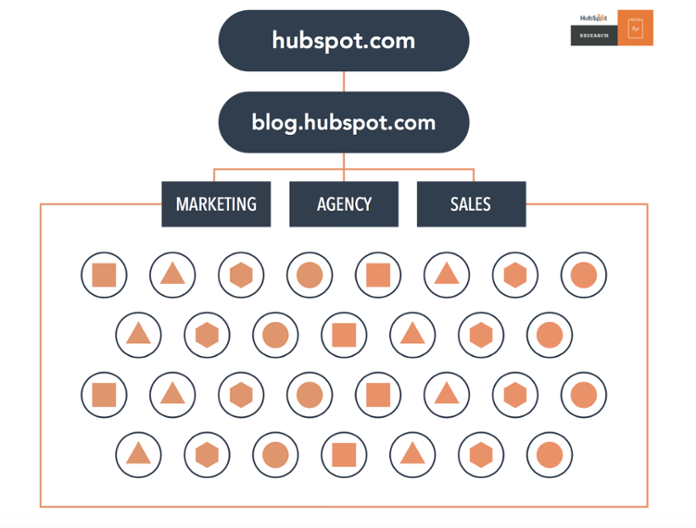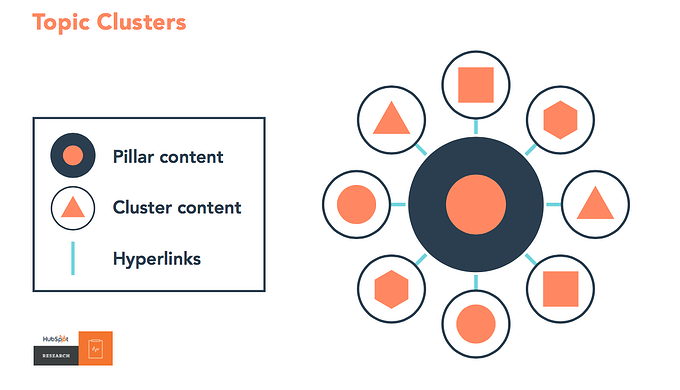Updated January 10, 2023
Reading Time: 5 minutes
Building Foundations
It’s trivia night and a friend invites you to join them. Surprisingly, when the first round starts the category isn’t about pop culture (e.g. 90s music, movies, or popular Oscar hosts). Instead, let’s pretend the trivia host throws the crowd a curveball with SEO history and the future of content marketing.
You immediately perk up because you’re in marketing. You tell your friends, “Don’t worry, I got this!”
The first question has multiple answers: “List three major Google search updates since 2011 that have shaped SEO strategies.” For you, this is easy. You pencil in the following: Panda, Penguin, and Hummingbird.
Your team gets it right and you’re eager for the next question. But the questions start getting hard. They dive into details about a shift in content marketing: the topic cluster model. Your team is relying on you but, honestly, you’re scratching your head.
While you’ve heard a little bit about topic clustering, you realize your company is not using it in their content strategy.
As a consequence, you may not be keeping pace with some crucial changes:
- Topic clustering is reshaping website architecture and search optimization.
- Search is shifting from fragmented keywords to complex questions.
- Google is moving toward deeper intent recognition.
How these changes are related to marketing and SEO isn’t readily apparent. So let’s take a look a closer look.
What are Topic Clusters?
The topic cluster model places an emphasis on topics and not just keywords. Essentially, a single page (known as a pillar page) becomes the main topic hub that connects to multiple content pages related to the overarching topic (cluster content).
When implemented, this new shift towards topics result in the following outcomes:
- It engenders better content and website structure.
- It helps Google easily identify your related content.
- It helps you drive authority and improve your search engine ranking.
Here’s a nifty view from HubSpot of how this content architecture looks:
Topic Clusters and Website Architecture
Older content strategies focused on addressing far too many variations of long-tail keywords—leading to repetitive posts that compete with one another.
It also led to disorganized websites and content architecture. For example, here’s what HubSpot’s website used to look like before they moved to the topic cluster model (notice how all the content lacks a pillar page and three different topics are mixed up in the same area):

How to Build Topic Clusters
Keywords
In the first image above, each individual piece of content (the cluster content) addresses a specific long-tail keyword. The pillar features the main keyword for the topic. Thus keywords are still imperative but they now operate within topics. So if you wanted to create content for the topic of SEO, your pillar page would be about SEO in general and then each cluster page would address specific keywords. Here are some fast examples of the cluster content keyword phrases:
- How does SEO work?
- What is White Hat SEO?
- How to measure SEO performance
- What are the best SEO strategies?
Linking
The pillar page links to each cluster piece and in turn each cluster piece links back to the pillar. (Important note: Each link should have the same hyperlinked keyword). To see this in action, take a look at HubSpot’s pillar page for SEO. Click on the internal links to see where they take you—and take note of both the words/phrases linked and the URL structures.
Topic Clustering Strategies
- Look closely at the services you provide and start with one. Next, focus on what problem(s) that service solves. (Important note: Make sure you never craft a pillar page that’s purely pushing your services and solutions. Educate the potential customer and hint that you have some solutions for the problems they’re looking to solve).
- Make sure the problem (aka pain point) is broad enough that you can create multiple pieces of cluster content around it.
- Do keyword research and find a keyword that’s strong for your business’ services—and to serve as the main keyword (main topic) of your pillar.
- Once your pillar page is up, begin building the cluster content around the pillar. Again, each cluster piece should focus on long-tail keyword variations related to the topic.
Start small and remember to track your performance. If you’re doing things well, you’ll achieve the following:
- Web crawlers will easily be able to interpret your new architecture with the connections you’re providing it.
- The algorithms will understand there’s a semantic relationship between your content.
- You’ll become a trusted authority and rank higher in search.
What’s the Difference Between Topic Clusters, Cornerstone Content, and Flagship Content?
A seasoned marketer you might think, “This sounds very similar to Cornerstone Content.” And you’re right; the principles and structure are remarkably the same (this is true of Flagship Content as well).
However, there are some key differences that topic clusters (aka pillar content) entail:
- The topic cluster model is designed so that the pillar pages can also be the main navigation pages of your website—not just long, drawn-out blog posts.
- This differentiation is optional. Some companies use pillar pages as lead generation magnets by offering forms to download the content. The pillar page will be very detailed and thus a longer read (but that’s okay because it’s rich in keywords and topics, and visitors will see a true value in it).
Why Does the Topic Cluster Model Matter?
Earlier we mentioned a few important changes that you want to keep up with:
- Differences in how people search.
- How Google’s algorithms are working to understand intent.
In 2013, Google’s Hummingbird wasn’t just an algorithmic update. It was an overhaul designed to help Google improve how it analyzed intent.
The details are complex but on the surface these improvements rely on two things: semantic search and the knowledge graph. Google’s foresight with Hummingbird also aligned them with something that’s reshaping the future of search: voice search.
Still, from a content and marketing perspective, it started the shift toward an emphasis on topics and not just keywords.
The technical details do matter, so stay tuned for a future post that will dive into some pretty cool advanced SEO insights:
- Why the topic clustering model helps Google better understand the semantic relationships between your content.
- How Google’s algorithms are working toward discerning intent.
- Can SEO cater to some of the latest Google algorithm updates?
- Why content entities matter in SEO.
Enough with the Hard Stuff: The Takeaways
Surprisingly, the main takeaways here are simple:
Start taking topic clustering seriously. It is a lot of work to rebuild the content structure and overall architecture of your website. But start small. Build your most important pillar page, and make that page part of your main website’s navigation (linking to your most popular, optimized blog posts that cover the same topic).
Photo credit – Top: Pexels
Photo credit – Bottom: Pexels



 Rich Result Reporting in Google Search Console
Rich Result Reporting in Google Search Console